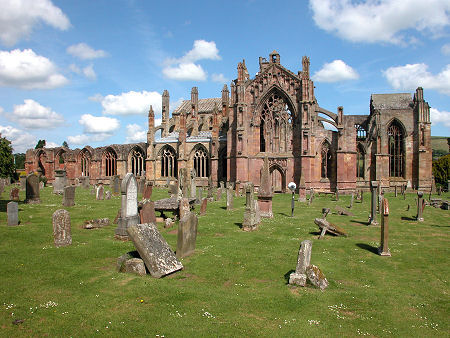
MELROSE ABBEY.
MELROSE ABBEY, one of the most celebrated ruins of the world, is situated in the town of Melrose, on the River Tweed, about forty miles from Edinburgh, Scotland. Three miles from Melrose is Abbotsford, the home of the great poet, Sir Walter Scott, who by his charming description in the
"Lay of the Last Minstrel" has thrown over the old ruin a halo of romance. It was first built by David I., of Scotland, and dedicated to the Virgin Mary, from which it was sometimes called St. Mary's Abbey and sometimes St. David's. It was afterward almost entirely destroyed by English invaders; but when the famous Robert Bruce came to the Scottish throne, he had the Abbey rebuilt, and restored to more than its former glory.
The Abbey originally consisted of a monastery and a church, but little except the ruins of the church now remains. These crumbling walls, though they have withstood the ravages and storms of five centuries, give to the traveler something of an idea of the departed glories of the ancient pile.
All along the centuries, the place has been despoiled by invading armies, and even in these latter days many of its stones and ornaments have been removed to help in beautifying other buildings.
Notwithstanding all this, the old ruin has been wonderfully well preserved, which shows that only the finest material was used in its building. The stone of which the Abbey was built is so hard that much of the ornamental work looks as if it had but just been cut. A traveler says that while looking at some of the windows, he could not but recall the description Scott gives of the place:—
"Thou would'st have thought some fairy's hand
'T wixt poplars straight the ozier wand,
In many a freakish knot had twined;
Then framed a spell, when the work was done,
And changed the willow-wreaths to stone."
For a century and a half the building and grounds have been owned by the Dukes of Buccleugh, and of late years they have done all they could to preserve the ruin from decay. Iron bars are placed here and there to hold the walls together. The old clock in the tower still goes, though its face is so worn that one can hardly tell the time; and it still strikes the hour as it did of old, when William of Deloraine went to the old abbey on his ghostly errand in the solemn midnight. The carving with which the whole inside is covered, is exquisitely beautiful,— no dragonheads and other hideous looking things, but sweet little cherub faces and beautiful flowers and plants of every description.
"Now slow and faint he led the way,
Where, cloistered round, the garden lay;
The pillared arches were over their head,
And beneath their feet were the bones of the dead:
Spreading herbs and flow'rets bright,
Glisten'd with the dew of night;
Nor herb, nor flow'ret glisten'd there
But was carved in the cloister-arches as fair."
Within the walls of the Abbey lie many of Scotland's noblest dead, and here, tradition says was buried the heart of Robert Bruce, King of Scotland. Perhaps the words of one who has actually visited the place, will give to it a greater reality than any other description could:—
"As we came into the midst of this glorious old structure, we actually stood silent for some moments, so filled were we with admiration at its wondrous beauty. To be sure, the blue arch of the heavens is now its only roof, and from its shattered walls rooks or jackdaws fly noisily over-head; but, then, the majestic sweep of the great Gothic arches; that vista of beauty, a great Gothic aisle still standing, fifty feet long, and sixty feet from door to keystone; the superb columns; and the innumerable elegant carvings on every side; the graves of monarch, knight, and wizard, marked with their quaint inscriptions at your feet; and—
The cloister galleries small, which at mid-height thread the chancel wall,'
all join to form a scene of most charming and beautiful effects.
"And we stood there, with the blue sky looking in through the shattered arches, the noisy rooks flying hither and thither on their morning calls;
the turf, soft, and green, and springy, sprinkled here and there with wild flowers, in the center of the ruin; while festoons of ivy waved in the breeze, like tapestry hung about the shattered windows and crumbling columns. Quaint Latin inscriptions on the walls and the timeworn slabs record the resting places of once proud but now extinct families and forgotten heroes—all now one common dust.
But what must it have been when nave and transept and aisle were perfect,
when the great windows were radiant glories of colored glass, the carvings fresh from the sculptor's chisel, and the chant of a hundred monks floated
through the lofty arches!"
The following lines written by Scott show how well he loved to wander and muse within the walls of the old ruin:—
"If thou would'st view fair Melrose aright,
Go visit it by the pale moonlight;
For the gay beams of lightsome day
Gild but to flout the ruins gray,
When the broken arches are black in night,
And each shafted oriel glimmers white;
When the cold light's uncertain shower
Streams on the ruin'd central tower;
When buttress and buttress, alternately,
Seem framed of ebon and ivory;
When silver edges the imagery,
And the scrolls that teach thee to live and die;
When distant Tweed is heard to rave,
And the owlet to hoot o'er the dead man's grave,
Then go—but go alone the while—
Then view St. David's ruined pile;
And home returning, soothly swear,
Was never scene so sad and fair."
E. B.